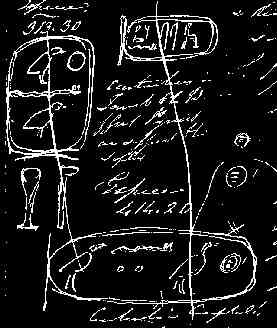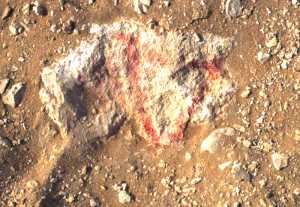

Anyone who, reading what Sitchin has to say on the subject of Cheops and the hieroglyphics that form the king’s name, examines the various images a little more closely, might come across a sequence of hieroglyphs that, though unremarkable at first sight, are in fact rather curious. I remember how I guffawed when I first saw the material in Sitchin‘s book.

|
| Fig. 1 - Horus name hieratic |
If Sitchin is right, the sequence of hieroglyphs in Stairway to Heaven as shown in table 145a (top left, inverted) cannot be there. Or, putting it another way: its presence is the ultimate proof that Sitchin is wrong.
This sequence of hieroglyphics spells out a name of Khufu which, at that time, in 1837, was unknown. Even better: at the time, it wasn’t even known that it was a name!
The name is "Mddw", the so-called Horus name of Khufu.

|
| Fig. 2 - Horus name in hieroglyphs |
The kings of ancient Egypt did not have just one name. Their full titulary consisted of no less than five names, together with a great many other titles.
The most important names were the birth- and throne-names, each of which was enclosed within the so-called cartouche. These names were mentioned in decrees and written down in king lists. To distinguish between the two names, special titles were placed before them. A goose and a sun disc (Sa-Re, Son of the Sun) were written in front of the birth name, whereas the throne name, the prenomen, was always preceded by a bee and a reed, signifying "king of upper and lower Egypt."
Those names were not only sequences of sounds that, like our names today, did not necessarily possess any particular significance in themselves; instead, they all had a meaning. The name chosen by the king as his throne name was really a political statement, such as "Lord of order" or "He who repeats the creation".
But not in the Fourth Dynasty! At that time, there existed no second cartouche name, and it’s even possible that Khufu’s father, Snofru, was the first king in Egyptian history to introduce a cartouche, the semblance of an oval of cord, to go around his birth name. In the same way, Khufu, Kafre, and Menkaure were also to use cartouches for their birth names.
The first king to use the cartouche for his throne name, as well as his birth name, was Neferirkare Kakai, the third king of the Fifth Dynasty (the names can be checked in J.v. Beckerath’s Handbuch der ägyptischen Königsnamen MÄS 49, Zabern 1999).
And before that? Well, the pharaoh only had his birth name depicted inside of a cartouche (which had, just to add to the confusion, the bee-reed-titulatory later associated with the throne-name in front), and the Horus name without any cartouche was used as a throne name! Those Horus names were not recorded in the New Kingdom king lists, which are the main sources for those names. The king lists only recorded cartouche names alone, and so Khufu became known to us through his birth-name only - and not by his throne name! And this birth name was the only name for the king known at Vyses time!
Khufu's throne name, "Mddw", means something approximating "He who dispenses" (goods to his people). But around the time of 1840 not even Birch knew about the meaning, or even of the existence of this name. Birch - who, according to Sitchin, was the greatest hieroglyphic expert of his time - now had the name right in front of him. He thought it was "just another title". So how could a faker entirely ignorant of hieroglyphics at all, know more than the worlds biggest expert on that subject?
One explanation comes from Sitchin himself: namely, that inscriptions were found in the surrounding tombs, and it might be possible that one of these included the Horus name. The forger just copied it from the tomb without knowing the significance of the name.
Unfortunately for Sitchin no such tomb is known, and the idea is anyway nonsensical, because of the circumstances the Horus name appears in. The quarry marks were not meaningless idle doodlings, the ancient Egyptian equivalent of "Kilroy was here". They had a function: to assign blocks to the different groups of workers. From discoveries in workmen's tombs, we know that the workforce was divided into four large groups, each one working on one side of the pyramid.
The inscriptions in the chambers represent precisely these four teams (Phylae), which are:
The joy of this is that each of these work-crew names has a royal name: so one instance of "Khufu", one instance of the extended form of the name, "Khnum-Khuu", and two versions of the Horus name! So we are not dealing with names in isolation: instead they form a part of a recognizable sequence of words used in a specific context annd at a specific location. The writer of these inscriptions was not only familiar with the Horus name: he also knew how to use it, and how to include it into a working-crew name. To do this, he needed knowledge not yet available to any hieroglyphics expert of the 1840s - knowledge of actual an ancient Egyptian!
The last final explanation for how a forger could have obtained the relevant knowledge would be if, in 1837, a work-crew name had been discovered in a tomb until 1837, but that- but that would be no good, either, as no tombs containing that information were found until the late 20th century.

|
| Fig. 3 - Page from Vyses journal Picture by Marin Stower |
Sitchin’s argumentation contains more weak points, as I shall now demonstrate.
Let us begin with the example of Vyse's journal, which is at present in the National Archives, publicly accessible. Martin Stower consulted it, and scanned several key pages, of which he was kind enough to send me copies.
According to Sitchin, Vyse believed that "Khufu" was written with a solar disc. And because of that the forger had written it in the chamber in the same way.
Sitchin claimed that Vyse had the infamous book "Materia Hieroglyphica" with him, and therefore expected to see a solar disc as first sign. However, Martin Stower discovered that this book was not on the inventory of Vyse's library compiled after his death, so it is questionable that he even knew the image in question. But it is also known that there are several examples where the first character of Khufu’s name is written with a solid disc, as on the Abydos king list. Perhaps the hatched marks were painted on. The disc at Abydos is also slightly smaller than the solar disc in the name of Khufu’s son, Djedefre.
On May 27, 1837, we find in Vyse's journal the first entry dealing with the Khufu-cartouche. Over the next few days, he began an analysis. Vyse, no expert on hieroglyphics, would have expected to find a solar disc as the first sign of Khufu’s name. Instead, he found a disc with hatch marks (since we know that, contrary to Sitchin's speculation, there is no copying error in the cartouche or its reproductions by Vyse and Perring). Still, he could not help wondering why this sign was NOT a solar disc. He couldn't make any sense of the "Kh", and therefore he spends this page of his journal wondering whether a "Re" could be written with lines inside it, instead of a dot.
He even copied a picture of a cartouche of Khufu that, written with a solid disc, had been found in a nearby tomb (Upper left side of the picture - the solid disc is clearly visible). On the right side, he notes that this disc can also be written with a dot in the middle (the small circle on top), and that he had expected one of these two forms – but notes that instead he found himself faced with a circle with three lines. So Vyse did not copy something from a book onto the walls - he found something that completely contradicted both a plate in a well known academic book, and also his own discovery in a tomb. I would say that that's a classical own goal for Sitchin and his forgery theory :-)

|
| Fig. 4 - Quarry mark on Kafres mastaba |
A last point: in an appareent bid to uphold his hypothesis that the Great Pyramid contained the sole example of quarry marks, Sitchin repeatedly refused to accept that quarry marks exist on other constructions. He also expressed scepticism about how, IF there were signs resembling quarry marks, could have survived for so many thousands of years and still look freshly made.
Well, one visit to Egypt could have answered all these questions. Quarry marks occur in locations too numerous to mention, multiple examples being visible in every pyramid complex and on every mastaba field, one only has to open his/her eyes to see them. The mark in this picture appears on a block on top of the mastaba of Khafre (Chefren), a son of Khufu and most probably the person responsible for the second great pyramid of Giza. The mark shown here is therefore at least as old as the Great Pyramid, and has probaply been exposed to weathering for a long periode of time. Yet ist is clearly visible and the colour is still quite fresh.
Another example can be visited in Dahschur: during excavations in the late 1990's, many blocks from the Red Pyramid were collected and brought to a spot on the south east side of the pyramid, each block bearing a distinctive red quarry mark just like the ones found in the Great Pyramid. Contrary to what Sitchin tries to make out, this form of marking was obviously nothing out of the ordinary at all, but a perfectly standard procedure.
Some defenders of Sitchin's thesis have been demanding that the pigment of the markings should be carbon dated, orchemical analyses carried out on them. If the results were not found to be in alignment with the range of the alleged construction of the pyramid that would be proof positive that the quarry marks were not authentic.
Unfortunately, the proponents of this school of thought don't appear to have read even Sitchin correctly on this subject. On pg. 311 of the German edition of Stairway to heaven, the author explicitely states that analyses of this sort would be pointless, because the same paint was still being used in Vyse's time as duringe the pyramid era: ochre, an iron oxide common in Egypt that lacks any organic constituent at all, and is therefore completely undateable.
It has happened. In 2014 pictures appeared that show that the Khufu-cartouche was vandalised by unknown people. At at least half a dozen locations paint has been chiselled away. Who is responsible, what happened to the paint, if it has been analyse and what the results were is still unknown to this day.
Better known is a later event. In 2013 two in Germany well known private researchers climbed illegally into the topmost relieving chamber and scraped some paint away[1] from an inscription in the corner. Their goal: to prove that the paint was modern and could not have be used by the ancient Egyptians. One of them, conspiracy ideologist Stefan Erdmann, firmly believes that the “true” pyramids were not constructed by primitive Egyptians.
In autumn of the same year the second person involved, Dr. Dominique Görlitz, claimed, according to the information of author Lars Fischinger[2], during a conference in Lennetal that the analysed paint was modern. This was immediately denounced by the Fresenius-institute which was then in possession of the sample. They told the press that they had not even started with the analysis.
Further confusion (for me) came from the claim of Dr. Görlitz that the institute has new, until then unknown dating methods able to date even inorganic material. That claim was never substantiated.
Word of these events, together with promotion videos in the internet, spread quickly around the world, and so the Egyptian ministry of antiquities got knowledge of the affair. And they were not pleased. They investigated and interned six Egyptians helping the Germans. They were sentenced to five years in prison, like the three involved Germans (the third one was Frank Höfer, owner of the esoteric media company Nuoviso who was filming the actions of Erdmann and Görlitz) which were sentenced in absence.
In Germany the three Germans had to pay penalty orders, and the sample was given back to the Egyptians. What has happened with them is unknown to date – August 2015 – but the Fresenius institute told in 2014 that the sample was too small to do any useful analysis.
As conclusion of all these events Stefan Erdmann claimed on another congress in Lennestadt in August 2015, that he found during visual examination of the Khufu cartouche evidence, that Howard Vyse indeed manipulated the inscription. Well...
They did not only take paint samples, but also samples from dark smudges on the ceiling of the King's Chamber. These were not given back to the Egyptians but instead analysed by the Fresenius institut. From the results they developed a new pyramid building thesis, which I will discuss in the section “Pyramid Building”.
| Remarks: | |
| [1] | I was astonished about the way Dr. Görlitz took the samples. To use the carbon dating method it must be guaranteed that the sample is not contaminated by modern carbon. To do this samples are taken with sterile tools from locations below the surface. This is not possible in these chambers because the walls are covered in soot from the lamps and torches of the visitors of the last two centuries. Also, the samples are normally put into a chemically inert container, i.e. glass tubes. Dr. Görlitz used bare hands and not sterilised tools to scrape the paint – into a textile cloth. Which was then transported in a plastic bag. This way any attempt to use the radio carbon method is futile. Later pictures appeared showing the sample in a proper glass container, but the film sequences of the (now deleted) promotion video showed what really happened. |
| [2] | private SMS during the congress |